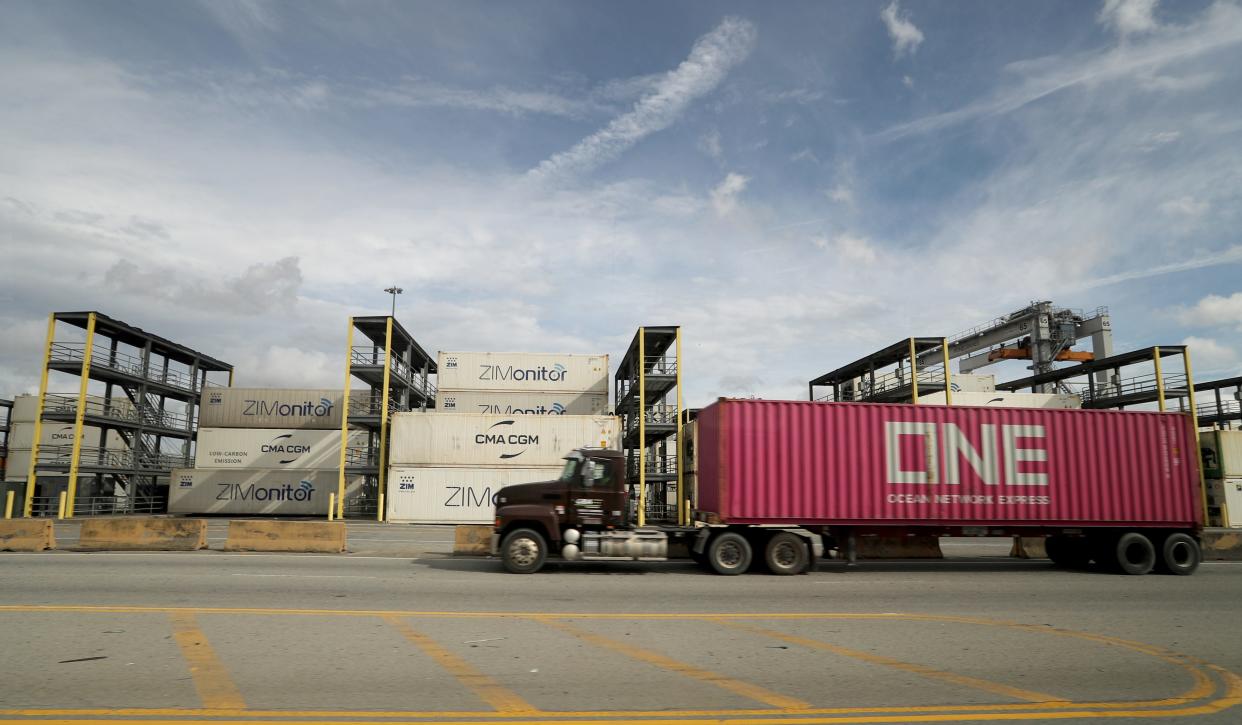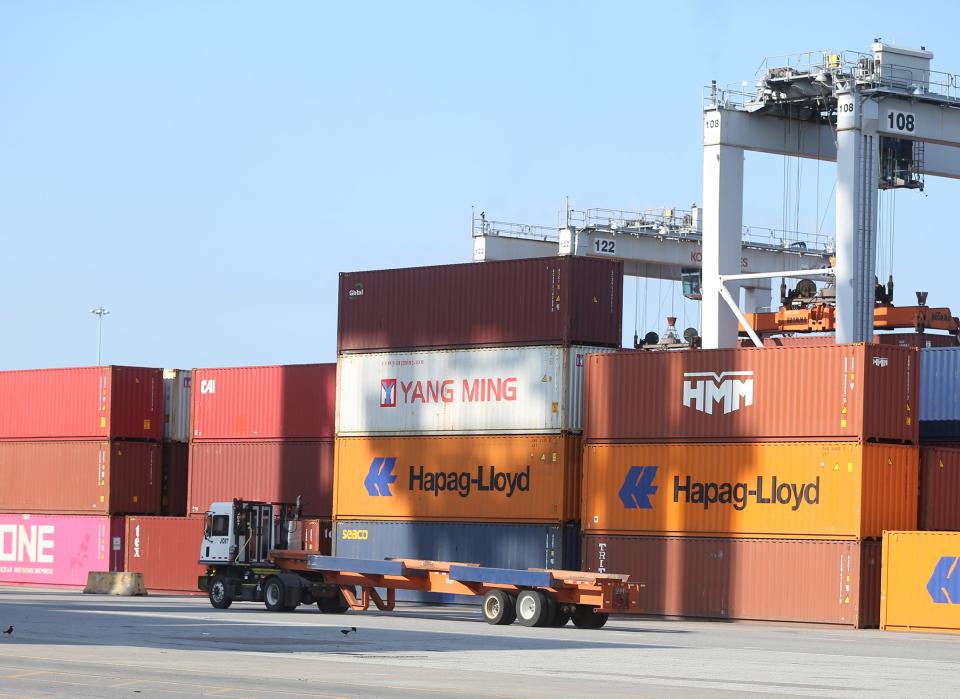Feds aim to slash Port of Savannah vehicle pollution with $15 million in funding

It's a typical weekday, so waves of tractor-trailers serving the Port of Savannah stream along Bourne Avenue as incessantly as an army of ants.
Only the traffic signals at Georgia Highway 21 succeed in interrupting the otherwise unceasing ebb and flow of big rigs carrying cargo containers.
In some cases, the receptacles have just been offloaded at the port while others are soon to be stacked like multicolored Lego blocks on waiting ships.
Other rigs haul tanks of fuel or carry bulk cargo like paper products and wood chips.
On days like this, roughly 3,200 trucks will make more than 13,000 such trips to or from the docks, according to the Georgia Ports Authority.
Meanwhile, at the port itself, hundreds of diesel-powered “jockey trucks” move containers – 5.4 million of them a year – within the 1,345-acre property.
While on the move, and when idling, nearly all those vehicles belch pollution that poses health risks to employees; drifts to nearby neighborhoods, schools and businesses; and contributes to climate change.
However, more than $15 million in recently announced federal funding is aimed at slashing truck pollution tied to the port, even with continued expansion.
Renewable diesel pilot project
A California-based clean-energy infrastructure company will put a $7.8 million grant from the Federal Highway Administration toward development of a 23-megawatt truck-charging center in Garden City. The facility will accommodate up to 120 electric versions of the trucks that move freight between the terminals and an ever-expanding array of adjacent warehouses and distribution centers.
Meanwhile, a $7.5 million grant to the GPA will support a four-year pilot project to replace more than 600 jockey trucks at the Port of Savannah with models using “renewable” diesel.
Renewable fuel, which can be mixed with traditional diesel, still pollutes when burned but has a smaller carbon footprint over its lifecycle because it is produced from raw materials such as used cooking oil and animal fat waste rather than refined from extracted oil.
The GPA will work with Terminal Investment Corporation, a truck manufacturer that supplies the fleets of jockey trucks used at the Port of Savannah.
Meanwhile the Georgia Tech Research Institute will measure and analyze the transition's impact on fuel efficiency and emissions.

Plugging in at the port
The truck purchase is the next step in the port’s decade-long effort to reduce the use of “dirty” diesel. That transition has focused primarily on electrifying major equipment once powered by fossil fuels, said Joanne Caldwell, GPA’s director of Risk Management and Sustainability.
“The current fleet of 34 electric-powered ship-to-shore cranes are equipped with integrated generators to capture power while lowering boxes,” Caldwell noted. “In this way, the cranes produce enough energy to power themselves for 18 minutes of each operating hour.”
GPA now is installing 15 all-electric rubber-tired gantry cranes at its Garden City Terminal West facility. Another nine are already in use at the Savannah Transload Facility, just upriver of the main Garden City Terminal.
Renovations at the Ocean Terminal in Savannah will include the use of hybrid cranes, which will be powered with batteries charged by diesel generators.
“GPA conserves 4.5 million gallons of diesel fuel each year by using electricity to power the 119 refrigerated container racks currently at the (Garden City Terminal), avoiding the use of diesel generators,” Caldwell added. “Each electrified reefer rack avoids the use of 54,000 gallons of diesel fuel each year and the associated release of (greenhouse gas) emissions into Georgia’s air.”
Other sustainability-related initiatives Caldwell cited include:
Retrofitting 11 rail locomotives with automatic engine stop-start devices that cut more than 52,000 gallons of diesel use and almost 16 tons of emissions each year.
Installing energy-efficient lighting controls and fixtures that reduce light pollution and cut energy consumption by more than 60 percent.
Using automated truck gates, extending gate hours and opening the new Cross Terminal Road, which have reduced truck “turn times” by 8 minutes for thousands of trucks daily.

Idle time is unhealthy
At Voltera’s charging center, the company says “high utilization” could lead to a reduction of 37,000 metric tons in heat-trapping carbon emissions annually.
The site at 2303 U.S. 80, about four miles from the port gates, was rezoned for the project last year.
“Savannah is home to the fastest-growing container terminal in America, and ports are particularly strong candidates for immediate electrification with respect to technology readiness and emissions reduction impact,” Voltera CEO Matt Horton said this week when asked why the company chose the Georgia site. “Electrifying the freight ecosystem is a strategic part of Voltera’s work, which has recently experienced considerable momentum following the release of the federal government's plans to scale zero-emission freight corridors.”
President Joe Biden in March unveiled a strategy for creating a system of charging and hydrogen-fuel infrastructure along the nation’s critical overland freight routes. That network plays a crucial role in combatting climate change because transportation accounts for the largest portion of carbon pollution nationally, with medium- and heavy-duty trucks making up about one-fourth of all transportation-related emissions, according to the EPA.
A large truck plugging into Voltera’s Savannah facility with a 20% charge will reach full power in 2.5 to three hours, Horton said.
Class 8 electric trucks like those that would serve the Port of Savannah have a typical range of about 275 miles between charges. That makes them better suited for the shorter “drayage” routes.
In all, the U.S. Department of Transportation’s Federal Highway Administration this week announced $148 million in grants to 11 states and Puerto Rico in the first round of a new $400 million program to improve air quality and reduce pollution for truck drivers, port workers and communities surrounding ports.
The Reduction of Truck Emissions at Port Facilities Grant Program, which was created by the 2023 Bipartisan Infrastructure Law, invests in port electrification and efficiency improvements aimed at reducing pollution from idling trucks while modernizing facilities and strengthening supply chains.
“When truckers spend hours idling at ports, it’s bad for drivers, bad for supply chains, and bad for nearby communities that feel the brunt of more polluted air,” U.S. Transportation Secretary Pete Buttigieg said in the announcement. “The investments ... will save truck drivers time and money and help ports reduce congestion and emissions, while making the air more breathable for workers and communities.”
John Deem covers climate change and the environment on the Georgia coast. He can be reached at jdeem@gannett.com
This article originally appeared on Savannah Morning News: USDOT awards $15M to reduce truck pollution at Port of Savannah

